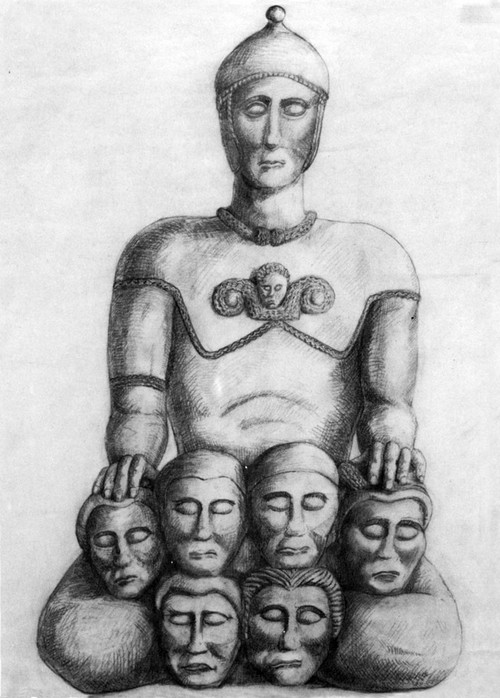"The heads of their most distinguished enemies they embalm in cedar-oil and carefully preserve in a chest, and these they exhibit to strangers..."
-Diodorus Siculus, Book 5, Chapter 29
...
"This fortified town built in 180BC by the Salyes, a tribe with a fairly evolved urban civilisation, was protected by a natural escarpment and by ramparts consisting of heavy curtain walls reinforced by towers. Inside the fort, the "upper town" was protected by another fortification, while the "lower town" seems to have been an artisanal district, where the remains of shops, warehouses and workshops can still be seen. Statuary from the site is exhibited in the Musée Granet.
In the Second Iron Age, archeology observed a multiplicity of heroic forms of worship, according to the social classes concerned and the weight of the political office associated with it. Contrary to the modest environment of the contemporary cremations honored in the habitats of Verduron or La Cloche (near Marseille), it is obviously the expression of the proximity of an aristocratic class that prevails in Entremont.
In Entremont, the heroes, armed warriors, surrounded by their trophies, are at the center or near the representation of the members of their aristocratic lineage, dunastai (Greek name designating, in the ancient sources on the Celto-Ligures, powerful aristocrats, with hereditary power) accompanied by their families."
-taken from viamichelin & archeologie.culture.fr link below
 |
| A "Hero of Entremont" reconstructed in a drawing. |
 |
| "In the Second Iron Age, archeology observed a multiplicity of heroic forms of worship, according to the social classes concerned and the weight of the political office associated with it. Contrary to the modest environment of the contemporary cremations honored in the habitats of Verduron or La Cloche (near Marseille), it is obviously the expression of the proximity of an aristocratic class that prevails in Entremont." |
 |
| "In Entremont, the heroes, armed warriors, surrounded by their trophies, are at the center or near the representation of the members of their aristocratic lineage, dunastai (Greek name designating, in the ancient sources on the Celto-Ligures, powerful aristocrats, with hereditary power) accompanied by their families." |
 |
| "The head of the deceased placed under one hand: its position on the knee of a warrior almost certainly designates it as one of the trophies brought back during his lifetime." |
 |
| Trophy head. |
 |
| Trophy head. |
 |
| Trophy head. |
 |
| Trophy head. |
 |
| Trophy head. |
 |
| Trophy head. |
 |
| Trophy head. |
 |
| Trophy head. |
 |
| Face of a warrior of aristocrat? |
 |
| Face of a warrior of aristocrat? |
 |
| Face of a warrior of aristocrat? |
 |
| Face of a warrior of aristocrat? |
 |
| Face of a warrior of aristocrat? |
 |
| Face of a warrior of aristocrat? |
 |
| Face of a warrior of aristocrat? |
 |
| Face of a warrior of aristocrat? |
 |
| Face of a warrior of aristocrat? |
 |
| The Celtic warrior/aristocrat heads side by side. |
 |
| Body of a warrior in what appears to be chainmail. |
 |
| Body of a warrior in what appears to be chainmail. |
 |
| Body of a warrior. |
 |
| Body of a warrior. |
 |
| Body of a warrior. |
 |
| Body of a warrior. |
 |
| Drawing of the three stone carvings below. |
Sources:
https://www.researchgate.net/figure/Statue-from-Entremont-whose-armour-is-interpreted-as-to-represent-chainmail-Fig-227_fig55_330933584
https://archeologie.culture.fr/entremont/fr
https://www.flickr.com/photos/thecolchesterkid/23048030584/in/photostream/
https://en.wikipedia.org/wiki/Entremont_(oppidum)
https://twitter.com/serbiaireland/status/1202902592650653701
Quotes:
https://penelope.uchicago.edu/Thayer/E/Roman/Texts/Diodorus_Siculus/5B*.html
https://archeologie.culture.fr/entremont/fr
https://www.viamichelin.com/web/Tourist-Attraction/Aix_en_Provence-13090-Oppidum_d_Entremont-a5c7d682


































Comments
Post a Comment